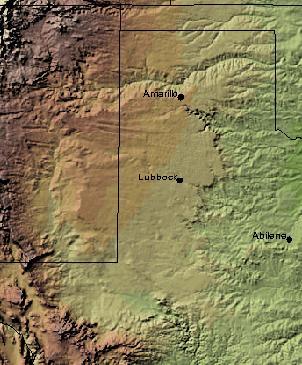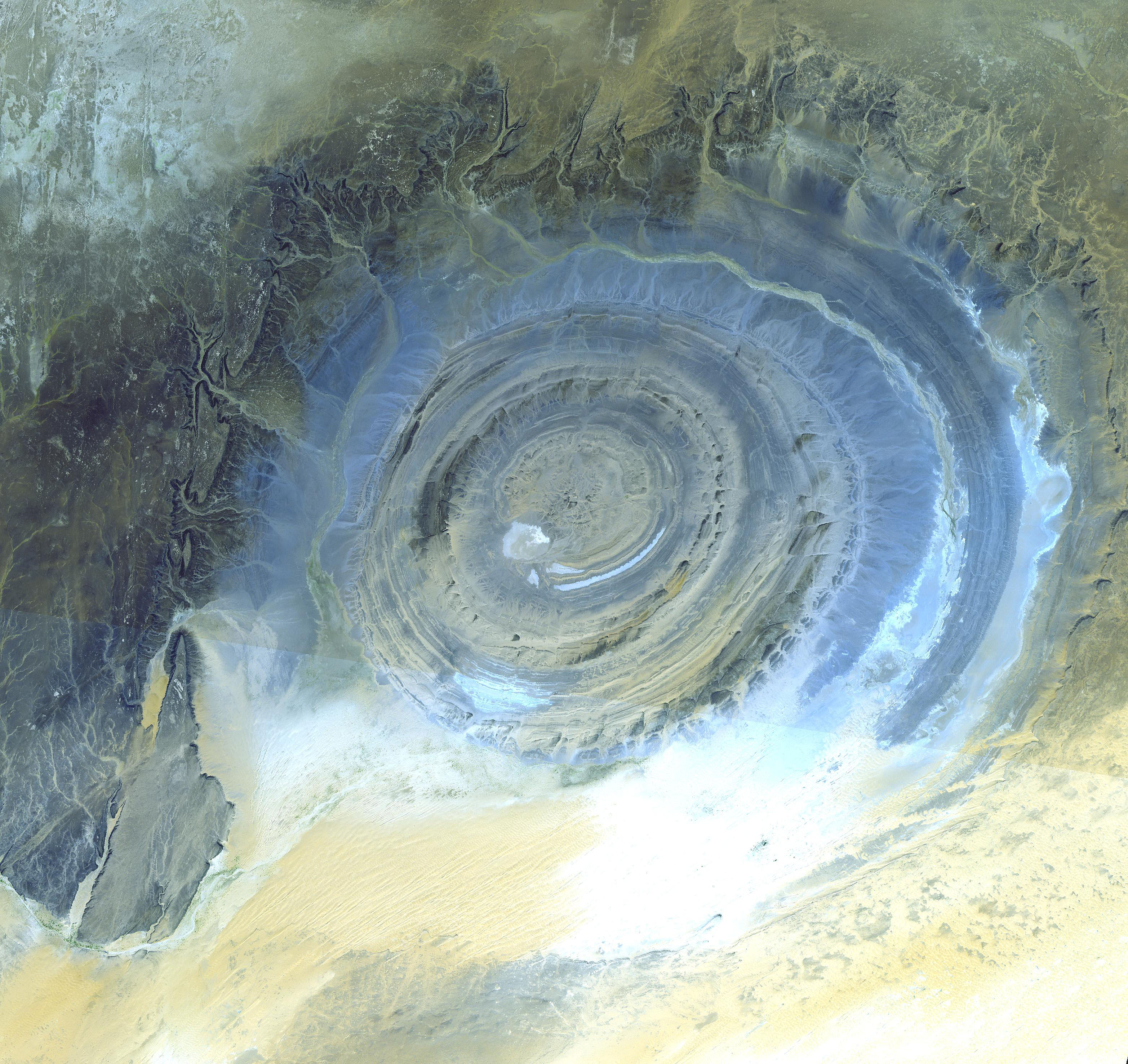|
Geology Of Texas
Texas contains a wide variety of geologic settings. The state's stratigraphy has been largely influenced by marine transgressive-regressive cycles during the Phanerozoic, with a lesser but still significant contribution from late Cenozoic tectonic activity, as well as the remnants of a Paleozoic mountain range. General geology Texas is approximately bisected by a series of faults that trend southwest to northeast across the state, from the area of Uvalde to Texarkana. South and east of these faults, the surface exposures consist mostly of Cenozoic sandstone and shale strata that grow progressively younger toward the coast, indicative of a regression that has continued from the late Mesozoic to the present. The coastal plain is underlaid by salt domes that are responsible for many of the oil traps in the region. North and west of the faults are the Stockton, Edwards, and Comanche plateaux; these define a crustal block that was upthrown during the Neogene. This large regio ... [...More Info...] [...Related Items...] OR: [Wikipedia] [Google] [Baidu] |
Crude Oil
Petroleum, also known as crude oil or simply oil, is a naturally occurring, yellowish-black liquid chemical mixture found in geological formations, consisting mainly of hydrocarbons. The term ''petroleum'' refers both to naturally occurring unprocessed crude oil, as well as to petroleum products that consist of refined crude oil. Petroleum is a fossil fuel formed over millions of years from anaerobic decay of organic materials from buried prehistoric organisms, particularly planktons and algae, and 70% of the world's oil deposits were formed during the Mesozoic. Conventional reserves of petroleum are primarily recovered by drilling, which is done after a study of the relevant structural geology, analysis of the sedimentary basin, and characterization of the petroleum reservoir. There are also unconventional reserves such as oil sands and oil shale which are recovered by other means such as fracking. Once extracted, oil is refined and separated, most easily by disti ... [...More Info...] [...Related Items...] OR: [Wikipedia] [Google] [Baidu] |
Dome (geology)
A dome is a feature in structural geology where a circular part of the Earth's surface has been pushed upward, tilting the pre-existing layers of earth away from the center. In technical terms, it consists of symmetrical anticlines that intersect each other at their respective wikt:apex, apices. Intact, domes are distinct, rounded, sphere, spherical-to-ellipsoidal-shaped protrusions on the Earth's surface. A slice parallel to Earth's surface of a dome features concentric rings of stratum, strata. If the top of a dome has been eroded flat, the resulting structure in Multiview_orthographic_projection#Plan, plan view appears as a Bullseye_(target), bullseye, with the youngest rock layers at the outside, and each ring growing progressively older moving inwards. These strata would have been horizontal at the time of Deposition_(geology), deposition, then later deformed by the Tectonic uplift, uplift associated with dome formation. Formation mechanisms There are many possible mechani ... [...More Info...] [...Related Items...] OR: [Wikipedia] [Google] [Baidu] |
Llano Uplift
The Llano Uplift is a geologically ancient, low geologic dome that is about in diameter and located mostly in Llano, Mason, San Saba, Gillespie, and Blanco counties, Texas. It consists of an island-like exposure of Precambrian igneous and metamorphic rocks surrounded by outcrops of Paleozoic and Cretaceous sedimentary strata. At their widest, the exposed Precambrian rocks extend about westward from the valley of the Colorado River and beneath a broad, gentle topographic basin drained by the Llano River. The subdued topographic basin is underlain by Precambrian rocks and bordered by a discontinuous rim of flat-topped hills. These hills are the dissected edge of the Edwards Plateau, which consist of overlying Cretaceous sedimentary strata. Within this basin and along its margin are down-faulted blocks and erosional remnants of Paleozoic strata which form prominent hills.Barnes, V.E., Bell, W.C., Clabaugh, S.E., Cloud, P.E., Jr., Young, K., and McGehee, R.V., 1962. ''Fie ... [...More Info...] [...Related Items...] OR: [Wikipedia] [Google] [Baidu] |
Edwards Aquifer
The Edwards Aquifer is one of the most prolific artesian aquifers in the world. Located on the eastern edge of the Edwards Plateau in the U.S. state of Texas, it is the source of drinking water for two million people, and is the primary water supply for agriculture and industry in the aquifer's region. Additionally, the Edwards Aquifer feeds the Comal River, Comal and San Marcos Springs, provides springflow for recreational and downstream uses in the Nueces River, Nueces, San Antonio River, San Antonio, Guadalupe River (Texas), Guadalupe, and San Marcos River, San Marcos river basins, and is home to several unique and endangered species. Basin characteristics Geography Located in South Central Texas, the Edwards Aquifer encompasses an area of approximately that extends into parts of 11 counties. The aquifer's boundaries begin at the groundwater divide in Kinney County, East of Brackettville, and extend Eastward through the San Antonio area and then Northeast where the aquif ... [...More Info...] [...Related Items...] OR: [Wikipedia] [Google] [Baidu] |
Texas Hill Country
The Texas Hill Country is a geographic region of Central and South Texas, forming the southeast part of the Edwards Plateau. Given its location, climate, terrain, and vegetation, the Hill Country can be considered the border between the American South and Southwest. The region represents the very remote rural countryside of Central Texas, but also is home to growing suburban neighborhoods and affluent retirement developments. The region is notable for its karst topography and tall rugged hills of limestone or granite. Many of the hills rise to a height of above the surrounding plains and valleys, with Packsaddle Mountain rising to a height of above the Llano River in Kingsland. The Hill Country also includes the Llano Uplift and the second-largest granite dome in the United States, Enchanted Rock. The terrain throughout the region is characterized by a thin layer of topsoil and many exposed rocks and boulders, making the region very dry and prone to flash flooding. N ... [...More Info...] [...Related Items...] OR: [Wikipedia] [Google] [Baidu] |
Cement
A cement is a binder, a chemical substance used for construction that sets, hardens, and adheres to other materials to bind them together. Cement is seldom used on its own, but rather to bind sand and gravel ( aggregate) together. Cement mixed with fine aggregate produces mortar for masonry, or with sand and gravel, produces concrete. Concrete is the most widely used material in existence and is behind only water as the planet's most-consumed resource. Cements used in construction are usually inorganic, often lime- or calcium silicate-based, and are either hydraulic or less commonly non-hydraulic, depending on the ability of the cement to set in the presence of water (see hydraulic and non-hydraulic lime plaster). Hydraulic cements (e.g., Portland cement) set and become adhesive through a chemical reaction between the dry ingredients and water. The chemical reaction results in mineral hydrates that are not very water-soluble. This allows setting in wet conditions or u ... [...More Info...] [...Related Items...] OR: [Wikipedia] [Google] [Baidu] |
Limestone
Limestone is a type of carbonate rock, carbonate sedimentary rock which is the main source of the material Lime (material), lime. It is composed mostly of the minerals calcite and aragonite, which are different Polymorphism (materials science), crystal forms of calcium carbonate . Limestone forms when these minerals Precipitation (chemistry), precipitate out of water containing dissolved calcium. This can take place through both biological and nonbiological processes, though biological processes, such as the accumulation of corals and shells in the sea, have likely been more important for the last 540 million years. Limestone often contains fossils which provide scientists with information on ancient environments and on the evolution of life. About 20% to 25% of sedimentary rock is carbonate rock, and most of this is limestone. The remaining carbonate rock is mostly Dolomite (rock), dolomite, a closely related rock, which contains a high percentage of the mineral Dolomite (mine ... [...More Info...] [...Related Items...] OR: [Wikipedia] [Google] [Baidu] |
Cretaceous
The Cretaceous ( ) is a geological period that lasted from about 143.1 to 66 mya (unit), million years ago (Mya). It is the third and final period of the Mesozoic Era (geology), Era, as well as the longest. At around 77.1 million years, it is the ninth and longest geological period of the entire Phanerozoic. The name is derived from the Latin , 'chalk', which is abundant in the latter half of the period. It is usually abbreviated K, for its German translation . The Cretaceous was a period with a relatively warm climate, resulting in high Sea level#Local and eustatic, eustatic sea levels that created numerous shallow Inland sea (geology), inland seas. These oceans and seas were populated with now-extinct marine reptiles, ammonites, and rudists, while dinosaurs continued to dominate on land. The world was largely ice-free, although there is some evidence of brief periods of glaciation during the cooler first half, and forests extended to the poles. Many of the dominant taxonomic gr ... [...More Info...] [...Related Items...] OR: [Wikipedia] [Google] [Baidu] |
Red River Of The South
The Red River is a major river in the Southern United States. It was named for its reddish water color from passing through red-bed country in its watershed. It also is known as the Red River of the South to distinguish it from the Red River of the North, which flows between Minnesota and North Dakota into the Canadian province of Manitoba. Although once a tributary of the Mississippi River, the Red River now is a tributary of the Atchafalaya River, a distributary of the Mississippi that flows separately into the Gulf of Mexico. This confluence is connected to the Mississippi River by the Old River Control Structure. The south bank of the Red River formed part of the US–Mexico border from the Adams–Onís Treaty (in force only in 1821) until the Texas Annexation and the Treaty of Guadalupe Hidalgo. The Red River basin is the second-largest in the southern Great Plains. It rises in two branches in the Texas panhandle and flows eastward, serving as a border between the ... [...More Info...] [...Related Items...] OR: [Wikipedia] [Google] [Baidu] |
Bexar County
Bexar County ( or ; ) is a county in the U.S. state of Texas. It is in South Texas and its county seat is San Antonio. As of the 2020 census, the population was 2,009,324, making it the state's fourth-most populous county. Bexar County is included in the San Antonio– New Braunfels, TX metropolitan statistical area. It is the 16th-most populous county in the nation and the fourth-most populated in Texas. Bexar County has a large Hispanic population with a significant growing African American population. With a population that is 59.3% Hispanic as of 2020, it is Texas' most populous majority-Hispanic county and the third-largest such nationwide. History Bexar County was created on December 20, 1836, and encompassed almost the entire western portion of the Republic of Texas. This included the disputed areas of eastern New Mexico northward to Wyoming. After statehood, 128 counties were carved out of its area. The county was named for San Antonio de Béxar, one of the 2 ... [...More Info...] [...Related Items...] OR: [Wikipedia] [Google] [Baidu] |
Brewster County
Brewster County is a county located in the U.S. state of Texas. It is in West Texas and its county seat (and only city) is Alpine. It is one of the nine counties that comprise the Trans-Pecos region, and borders Mexico. Brewster County is the largest county by area in the state - at it is over three times the size of the state of Delaware, and more than bigger than Connecticut. As of the 2020 census, the population was 9,546. The county is named for Colonel Henry Percy Brewster, a Secretary of War for the Republic of Texas. History Native Americans Paleo-Indian hunter-gatherers existed in the region at least 9000 years ago. Mescalaro Apaches emerged later and conducted raids that discouraged settlers. Between 1779 and 1787, Col. Juan de Ugalde drove the Mescalaros back north across the Rio Grande and into the Chisos Mountains. The three leading Mescalero chiefs, Patula Grande, Quemado, and Zapato Tuerto, agreed in March 1789 to submit to Spanish rule. Comanche raidi ... [...More Info...] [...Related Items...] OR: [Wikipedia] [Google] [Baidu] |










